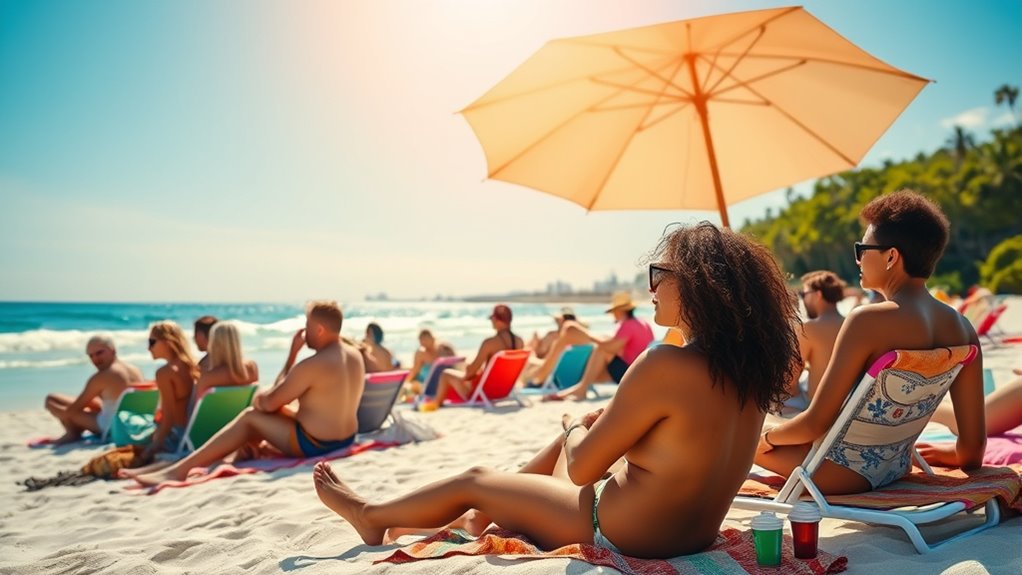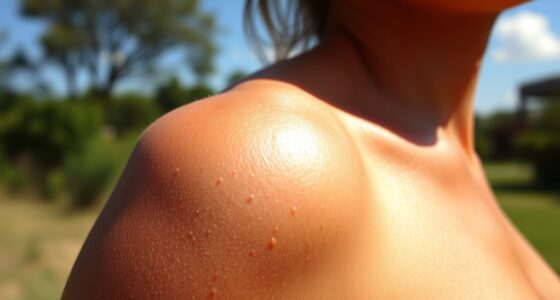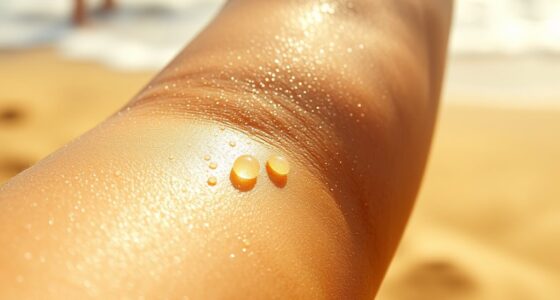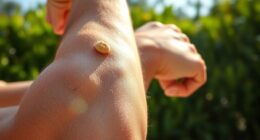Many believe tanning shows good health, but it actually masks skin damage from UV rays that accelerate aging and raise cancer risks. A base tan offers minimal protection—around SPF 2 or 3—and doesn’t prevent future burns. Tanning is a sign of skin trying to defend itself, not staying healthy. If you want to protect your skin and keep it youthful, understanding these myths is key. Keep exploring to learn how to stay safe in the sun.
Key Takeaways
- Tanning is a UV damage response, not a sign of good health or immunity.
- A base tan provides minimal protection (SPF 2-3) and does not prevent future burns.
- Darker skin from tanning indicates increased UV damage, not health benefits.
- Tanning accelerates skin aging, causing wrinkles, sagging, and age spots.
- Safer alternatives like sunscreen and protective clothing effectively prevent UV damage without risks.

Have you ever wondered whether tanning is truly as harmful as people say? Many believe that a quick sunbathe or a session in a tanning bed isn’t that dangerous, but the truth is more complex. When you expose your skin to UV rays, whether from the sun or artificial sources, you’re increasing your risk of skin aging and other health issues. UV exposure damages the collagen and elastin in your skin, leading to premature wrinkles, fine lines, and sagging. This process of skin aging isn’t just about looking older; it also makes your skin more vulnerable to other problems, like age spots and uneven pigmentation. So, that seemingly harmless tan might be doing more damage than you realize, even if it doesn’t immediately seem obvious.
Tanning damages collagen, accelerates aging, and increases skin cancer risk—protect your skin for the future.
A common myth is that tanning gives you a healthy glow, but in reality, the tan you see is your skin’s response to UV damage. When UV rays penetrate your skin, your body produces more melanin—your natural pigment—as a defense mechanism. This increase in melanin causes the skin to darken, creating that tan appearance. However, that darkening isn’t a sign of good health; it’s a sign that your skin is trying to protect itself from further damage. The more you tan, the more you’re exposing your skin to harmful UV rays, which accelerates the aging process and increases your chances of developing skin cancers.
Many think that a base tan can protect them from future sunburns or skin damage. But this is a dangerous misconception. A tan, whether from the sun or a tanning bed, offers very minimal protection—equivalent to SPF 2 or 3—meaning your skin is still vulnerable to UV radiation. Relying on a tan for protection can lead to overexposure without realizing it, increasing your risk of long-term skin damage and premature aging. Instead of chasing a tan, it’s smarter to use broad-spectrum sunscreen, avoid peak sun hours, and wear protective clothing.
Understanding the effects of UV radiation helps you make smarter choices about tanning. It’s not just about avoiding burns or cosmetic concerns; it’s about protecting your skin’s health for the long run. Tanning may seem like a quick way to look good temporarily, but the hidden costs—accelerated skin aging and increased cancer risk—are far too high. Recognizing that a tan isn’t a sign of health and that UV exposure speeds up skin aging can motivate you to adopt safer habits. Your skin will thank you later, and you’ll preserve its youthful appearance and health for years to come.
Frequently Asked Questions
Does Indoor Tanning Prevent Vitamin D Deficiency?
Indoor tanning doesn’t effectively prevent vitamin D deficiency because UV exposure effects vary, and overexposure can harm your skin. While UV rays help with vitamin D synthesis, indoor tanning often doesn’t provide enough safe UV exposure to meet your needs. Relying on tanning beds isn’t a healthy or reliable method. Instead, consider vitamin D-rich foods or supplements, which are safer and more effective for maintaining ideal vitamin D levels.
Are All Tanning Beds Equally Safe?
A leopard can’t change its spots, and not all tanning beds are equally safe. You should know that tanning bed regulations vary by location, and some devices may expose you to higher UV levels than others. Always check for compliance with UV exposure limits and safety standards. Be cautious, because even with regulations, overexposure can increase skin cancer risks. Never assume all tanning beds are safe—do your research first.
Can Tanning Improve My Mood or Mental Health?
Yes, tanning can improve your mood or mental health through sunlight therapy, which exposes you to natural or artificial light. This light helps boost serotonin levels, promoting mood enhancement and reducing symptoms of depression or seasonal affective disorder. Keep in mind, though, that overexposure to UV rays from tanning beds can be harmful. Balance your mood benefits with safe practices, and consider natural sunlight or light therapy devices for safer mood improvement.
How Does Tanning Affect Skin Aging Over Time?
Tanning accelerates skin aging by causing collagen breakdown, which reduces skin elasticity over time. When you tan, UV rays damage your skin’s structure, leading to wrinkles and sagging. This process happens gradually, making your skin look older faster. To protect your skin’s youthful appearance, it’s best to avoid excessive sun exposure and use sun protection. Staying safe now helps maintain your skin’s firmness and elasticity in the long run.
Is Natural Sunlight Safer Than Tanning Beds?
Natural sunlight isn’t necessarily safer than tanning beds because both expose you to UV radiation, which can cause skin damage. While sunlight is free and easy to access, it still increases your risk of skin aging and skin cancer with prolonged exposure. Tanning beds often emit concentrated UV rays, making damage more intense. Either way, protecting your skin with sunscreen and limiting exposure is the best way to reduce risks.
Conclusion
Think of tanning myths as tangled vines blocking your path to healthy skin. By clearing these misconceptions, you’re like a gardener pruning away the falsehoods that hinder your understanding. As you walk forward, armed with facts, you’ll see the journey to safe tanning becomes clearer and brighter. Don’t let myths be the overgrown weeds in your skincare garden—cultivate knowledge and enjoy the sunshine responsibly. Your skin’s health is worth every effort.









